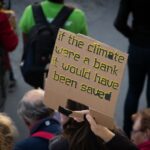The Role of Science in Climate Change Litigation
Environmental degradation, a pressing global issue, is a complex phenomenon with a multitude of contributing factors. Numerous entities, ranging from corporations to governments and individuals, share varying degrees of responsibility for this ongoing damage.

This article seeks to dissect the intricate web of accountability, assessing the role and impact of different entities in the current environmental crisis. It will examine the contribution of corporations to global warming, the implications of government policies on the environment, and the significance of individual carbon footprints.
Additionally, it will consider the effects of industrialization on ecosystems, the role of deforestation and agriculture in climate change, and the impact of consumerism and urbanization on waste production and biodiversity.
Furthermore, it will explore the critical intersection of environmental justice and accountability. Detailed insight into these aspects will inform a comprehensive understanding of responsibility for environmental damage.
Key Takeaways
- Corporations, governments, and individuals all share varying degrees of responsibility for environmental damage.
- Holding corporations accountable for their environmental practices is imperative.
- Urgent action is needed to ensure that corporations adopt environmentally friendly practices.
- Governments play a crucial role in directing environmental health through legislation, but policy loopholes can undermine the effectiveness of environmental laws.
The Role of Corporations in Global Warming
Corporations, particularly those in the fossil fuel and industrial sectors, significantly contribute to global warming through substantial greenhouse gas emissions, thereby playing a pivotal role in environmental degradation. The fossil fuel industry, notorious for its high carbon footprint, is a major driver of climate change. Despite attempts to transition to cleaner energy sources, many corporations continue to rely heavily on coal, oil, and natural gas, thereby exacerbating global warming.
An alarming trend among corporations is the practice of corporate greenwashing, where businesses misrepresent their environmental practices to appear more sustainable than they truly are. This deceptive practice undermines genuine efforts to combat climate change and often misleads consumers and regulators. Regulatory frameworks such as the Paris Agreement and the Kyoto Protocol have been established to curb greenhouse gas emissions. However, their effectiveness is often compromised by non-compliance and lack of enforcement.
The fossil fuel industry, in particular, has been accused of using corporate greenwashing to downplay its environmental impact and resist changes in environmental laws. This resistance presents a significant hurdle in the global fight against climate change. Thus, it becomes imperative for governments, regulatory bodies, and citizens to hold corporations accountable for their environmental practices.
Accountability measures, stringent enforcement of environmental laws, and increased transparency in reporting could potentially mitigate the damaging effects of corporate activities on the environment. It is apparent that the role corporations play in environmental degradation is substantial and cannot be ignored. Urgent action is required to ensure that corporations adopt environmentally friendly practices and contribute positively to the fight against climate change.
Government Policies and Their Impact on the Environment
Legislation enacted by governmental bodies plays a pivotal role in shaping the health and well-being of our natural world. The enactment, enforcement, and interpretation of environmental laws significantly shape the trajectory of environmental conservation and degradation. Therefore, the government, as a policy-maker and enforcer, holds substantial power in directing the course of environmental health.
At times, policy loopholes can undermine the effectiveness of environmental laws. Such loopholes may inadvertently enable activities causing environmental harm to persist, shielding them from legal repercussions. For instance, certain industries may exploit these gaps to evade stringent environmental standards, leading to unchecked pollution and resource exploitation. Hence, robust legislative frameworks are essential in ensuring that such policy loopholes do not compromise environmental integrity.
Green legislations, which seek to promote sustainable practices and mitigate environmental harm, represent an essential tool in the government's arsenal for environmental protection. These laws can drive the transition towards a more sustainable economy by encouraging the adoption of green technologies, promoting energy efficiency, and discouraging harmful practices. However, the efficacy of green legislations hinges on their effective implementation and enforcement.
The impact of government policies on the environment is not limited to direct regulatory measures. Fiscal policies, trade agreements, and development plans can indirectly shape environmental outcomes by influencing economic activities and their associated environmental footprints. Therefore, it is crucial to integrate environmental considerations into all facets of policy-making.
A comprehensive approach to environmental protection requires governments to rigorously scrutinize their policies, identifying and addressing potential policy loopholes, and reinforcing commitment towards green legislations. This approach will ensure that the government's role as a custodian of the environment is effectively fulfilled.
Individual Carbon Footprints
Individual actions significantly contribute to global greenhouse gas emissions, thereby shaping the collective carbon footprint. The decisions made by individuals on a daily basis have a substantial impact on the environment, particularly with reference to the carbon emissions generated through everyday activities. These emissions are derived from various areas of an individual's lifestyle, including diet, transport, home energy use, and consumer choices.
The concept of Green Travel is one area where individual carbon footprints can be reduced. This involves choosing more environmentally-friendly methods of transportation such as walking, cycling, or using public transport, over more carbon-intensive means like private cars or airplane travel. Furthermore, opting for vacation destinations that prioritize conservation and eco-friendly practices also aids in reducing carbon footprints.
In addition, the adoption of Sustainable Fashion significantly aids in curbing environmental damage. The fashion industry is one of the largest polluters globally, with massive energy consumption and carbon emissions. Sustainable Fashion involves making choices that prioritize the use of organic materials, recycling, and ethical production processes, which all contribute to reducing the industry's carbon emissions.
The responsibility of environmental protection does not solely lie with governments and corporations. Each individual, through mindful practices such as Green Travel and Sustainable Fashion, can make a considerable impact on reducing global carbon emissions. The adoption of such practices, combined with an increased awareness of one's environmental footprint, can guide individuals towards a more sustainable lifestyle, thereby reducing their contribution to environmental damage. This shift, if adopted on a large scale, can lead to a significant reduction in global greenhouse gas emissions.
The Impact of Industrialization on Ecosystems
Rapid industrialization has markedly altered ecosystems, with a profound influence on biodiversity and the overall health of the planet. Unchecked growth in the name of progress has led to significant degradation of natural habitats driving many species to the brink of extinction. The Industrial Evolution, which began in the 18th century, initiated a cycle of environmental damage that continues to this day, reflecting the inherent conflict between economic growth and environmental sustainability.
The impact of industrialization on ecosystems is not just limited to the degradation of biodiversity, but extends to climate change as well. The overreliance on fossil fuels and the resultant greenhouse gas emissions have led to a steady rise in global temperatures. This has triggered a series of climate-related disasters, such as droughts, floods, and hurricanes, which further exacerbate the environmental damage caused by industrialization.
However, the emergence of Green Technologies offers a hopeful counterpoint to this bleak narrative. These technologies aim to mitigate the environmental impact of industrialization by harnessing renewable resources, promoting energy efficiency, and reducing carbon footprint. They exemplify how economic growth and environmental sustainability can coexist, provided there is a conscious effort to align industrial processes with ecological considerations.
Despite the promise of Green Technologies, the responsibility of safeguarding the planet's ecosystems cannot be abdicated to technology alone. It requires concerted efforts from individuals, industries, and governments alike. Rigorous enforcement of environmental laws and stringent penalties for violations are essential to ensure that industrial processes do not compromise the health of the planet's ecosystems. This collective effort is not just a necessity but an obligation for all to ensure a sustainable future.
Deforestation and its Perpetrators
Deforestation, often driven by industrial expansion, agricultural practices, and urbanization, poses a substantial threat to the planet's terrestrial biodiversity and contributes significantly to climate change. This loss of forest cover, particularly in tropical deforestation, is alarming, given that these regions serve as the world's largest carbon sinks and are home to a vast array of flora and fauna.
In recent years, the rate of deforestation has accelerated, largely due to human activities, prompting a pressing need to identify and hold accountable the primary perpetrators.
Foremost among the culprits of deforestation are industries engaging in illegal logging. Despite stringent environmental laws and regulations, this illicit activity continues unabated, primarily driven by the high demand for timber and non-timber forest products. Often operating under the cloak of darkness, these illegal entities wreak havoc on precious forests, leaving a trail of environmental devastation in their wake.
Similarly, the agriculture sector plays a prominent role in deforestation. The relentless quest for arable land often leads to the clearing of forests, thereby leading to significant habitat destruction. In the case of tropical deforestation, the conversion of forests into palm oil plantations and cattle ranches is rampant, further escalating the ecological crisis.
Simultaneously, rapid urbanization, underpinned by population growth and economic development, has led to the encroachment of forest lands. Infrastructure development, housing projects, and expansion of transport networks often necessitate deforestation, thus exacerbating environmental damage.
Addressing the issue of deforestation requires a multi-pronged approach that includes stringent enforcement of environmental laws, promoting sustainable agricultural practices, and implementing effective land-use planning. It is imperative to hold the perpetrators accountable to mitigate the adverse effects of deforestation and preserve the planet's biodiversity.
Pollution and its Main Causes
Pollution, an escalating global concern, is primarily driven by several factors including industrial emissions, improper waste disposal, and extensive use of fossil fuels.
Industrialization is a double-edged sword, while it has propelled economies forward, it has also resulted in the release of harmful pollutants into the atmosphere. These pollutants affect air quality, contribute to climate change, and lead to diseases such as asthma and cancer.
Improper waste disposal is another significant contributor to pollution. This is evident in the growing problem of oceanic pollution. Plastics, metals, and other non-biodegradable materials are dumped into oceans, which not only disrupts marine ecosystems but also culminates in the formation of Trash Islands. These are large floating patches of debris, the largest of which is referred to as the Great Pacific Garbage Patch, spanning twice the size of Texas.
The extensive use of fossil fuels for transportation and electricity production has increased the levels of carbon dioxide and other greenhouse gases in the atmosphere. These emissions not only cause air pollution but are also the primary drivers of global warming and climate change. The combustion of fossil fuels also releases pollutants like sulfur dioxide and nitrogen oxides that lead to acid rain, damaging forests, lakes, and even infrastructure.
While stringent environmental laws are in place to control pollution, their enforcement remains a challenge. The responsibility to protect the environment does not lie solely with the government but with every individual, corporation, and nation. A collective effort is required to reduce pollution levels and mitigate their damaging effects on the environment. This includes shifting towards renewable energy sources, advocating for waste reduction, and promoting sustainable industrial practices.
The Contribution of Agriculture to Climate Change
Industrial farming practices contribute significantly to climate change through the emission of greenhouse gases such as methane and nitrous oxide. These emissions primarily stem from the use of synthetic fertilizers, the management of livestock waste, and the digestion process of ruminant animals. The Food and Agriculture Organization (FAO) estimates that livestock farming contributes to 14.5% of all anthropogenic greenhouse gas emissions.
Farming innovations have attempted to mitigate these impacts. For instance, the development of precision agriculture techniques, which rely on technology to apply fertilizers and pesticides more efficiently, has the potential to reduce nitrous oxide emissions. However, it is also crucial to note that these innovations can sometimes lead to unanticipated environmental consequences. The overreliance on technological solutions could lead to soil degradation, a significant concern as healthy soils are vital for carbon sequestration.
Furthermore, agricultural laws and policies often fail to adequately address these issues. For instance, the European Union's Common Agricultural Policy, while it has introduced some measures to promote sustainable farming, has been criticized for not doing enough to reduce greenhouse gas emissions from the agricultural sector. The gap between policy and practice underscores the need for comprehensive legal frameworks that prioritize environmental protection.
Addressing the contribution of agriculture to climate change requires a multifaceted approach. This approach should encompass not only the adoption of sustainable farming practices and technological innovations but also the promotion of robust environmental legislation. It serves as a crucial reminder that responsibility for environmental damage extends beyond individual actions to include the agricultural industry and policy-making bodies.
Consumerism and Waste Production
Escalating rates of consumption have led to a surge in waste production, a trend posing significant challenges for waste management systems around the globe. This marked increase in waste is directly linked to the rise of consumerism. As societies become more affluent, the demand for goods and services increases, leading to higher levels of production and consumption.
One of the key drivers of this consumerism is the demand for new, up-to-date products, often at the expense of older, still functional items. This throwaway culture not only contributes to the volume of waste but also exhausts finite natural resources, thus exacerbating environmental degradation.
However, the responsibility for this environmental damage extends beyond consumers. Producers and retailers also bear a significant portion of the blame. They often encourage consumerism through aggressive marketing tactics and planned obsolescence, thereby increasing waste production. Additionally, inadequate recycling efficacy in many regions results in materials that could be reused or repurposed being discarded, further exacerbating the problem.
Addressing this issue requires a collective effort from all stakeholders. Consumers can mitigate their environmental impact through sustainable shopping practices, such as purchasing second-hand items, choosing products with less packaging, and opting for goods that are durable and repairable. Producers and retailers, on the other hand, can improve the sustainability of their operations by designing products for longevity, promoting recycling, and reducing packaging.
While these actions are crucial, they must be supported by robust environmental laws and regulations. These should be designed to not only encourage sustainable practices but also to hold both consumers and producers accountable for their environmental impact. Such measures can significantly reduce waste production, thereby alleviating the strain on global waste management systems.
The Effects of Urbanization on Biodiversity
Rapid urbanization, characterized by the transformation of natural landscapes into built environments, presents significant threats to biodiversity globally. This pervasive phenomenon, often synonymous with escalating human population and economic growth, triggers ecological disruptions, consequently causing the loss of habitats, species displacement, and decline in biodiversity.
The concept of urban sprawl consequences has become a critical facet of environmental discourse, with urban areas expanding into natural habitats, leaving wildlife and plant species vulnerable and often resulting in their extinction.
Urbanization not only alters the physical characteristics of landscapes but also modifies climate patterns, leading to extreme weather conditions. This subsequently impacts the availability of resources for native species, disrupting ecosystems and causing irreversible damage to biodiversity. The urban heat island effect, a byproduct of urbanization, further exacerbates these issues by escalating temperatures in urban areas, leading to a decline in biodiversity.
However, adopting strategies like urban greening can mitigate the adverse effects of urbanization on biodiversity. Urban greening benefits are manifold. It promotes the creation of urban green spaces, such as parks, gardens, and green rooftops, which can serve as habitats for numerous species. These green spaces can also act as crucial corridors, facilitating species movement and preventing their isolation in urban jungles. Moreover, urban greening can temper the urban heat island effect, helping to sustain local biodiversity.
Recognizing the significance of biodiversity, environmental laws must be reinforced to regulate urban development, ensuring it incorporates sustainable practices like urban greening. Adequate monitoring and stringent enforcement of these laws can help strike a balance between urbanization and biodiversity conservation, thus fostering a harmonious coexistence between man and nature.
The Intersection of Environmental Justice and Accountability
Shifting focus from the impact of urbanization on biodiversity, it is imperative to examine the nexus of environmental justice and accountability, a facet that plays a significant role in the discourse of responsibility for environmental damage. This intersection is a critical area of study that helps in understanding the disparities in the burden of environmental harm and the inequitable enforcement of environmental laws.
Environmental justice is a principle that advocates for the fair treatment and involvement of all people, irrespective of their race or income, in the enactment and enforcement of environmental laws and regulations. However, justice disparities often arise due to the unequal distribution of environmental benefits and burdens. Often, marginalized communities bear the brunt of environmental damage, while wealthier entities escape accountability through loopholes or 'Greenwashing' tactics.
Greenwashing, a deceptive practice where an organization spends more resources claiming to be 'green' through marketing and public relations than actually implementing practices that minimize environmental impact, further exacerbates justice disparities. These tactics can mislead the public about the extent of an organization's environmental responsibility, allowing it to avoid accountability for its environmental harm.
This manipulation underscores the importance of holding accountable those responsible for environmental damage. It calls for stringent and equitable enforcement of environmental laws to ensure that all parties bear the appropriate amount of responsibility for their actions. It also necessitates the development of strategies to counter greenwashing, such as improved transparency and stricter regulations on environmental claims.
This exploration of environmental justice and accountability illuminates the necessity for a comprehensive approach to environmental responsibility, which includes not only protecting biodiversity but also ensuring justice is served.
Frequently Asked Questions
How does the tourism industry contribute to environmental damage?
The tourism industry significantly contributes to environmental damage, primarily through its carbon footprint. Travel, particularly air travel, emits substantial greenhouse gases, exacerbating global warming.
Additionally, mass tourism often leads to habitat destruction and pollution.
While sustainable travel practices are being implemented to mitigate these impacts, the scale of the tourism industry's environmental footprint remains considerable.
Therefore, transitioning to more sustainable models of tourism is not just a desirable option, but a necessity for global environmental preservation.
What role does the fashion industry play in environmental pollution?
The fashion industry significantly contributes to environmental pollution, particularly through fast fashion impacts. Fast fashion's high turnover rate leads to excessive production, resulting in notable carbon emissions and waste. Additionally, pollution occurs from the industry's use of toxic dyes and non-biodegradable materials.
Conversely, sustainable fashion attempts to mitigate these effects by prioritizing environmentally-friendly materials and practices.
Thus, understanding the environmental implications of this industry is crucial for formulating effective environmental policies and promoting sustainable practices.
How does the use of personal electronic devices contribute to e-waste and environmental harm?
Device disposal concerns arise from the improper disposal of personal electronic devices. These devices contribute significantly to e-waste and environmental damage.
Personal electronic devices contain harmful elements that, when improperly discarded, leak into the environment. This leads to soil, water, and air pollution.
Sustainable technology solutions such as recycling and materials recovery can help mitigate these environmental impacts. However, their effective implementation requires stringent environmental laws and public awareness.
Promoting responsible e-waste disposal and recycling practices is crucial in order to address these issues.
What is the impact of space exploration on the environment?
Space exploration contributes significantly to environmental degradation. One of the main ways it does this is through rocket fuel pollution. The combustion of rocket propellants releases harmful substances into the atmosphere, which can exacerbate global warming. This pollution adds to the overall burden on the environment and contributes to the degradation of air quality.
Another environmental impact of space exploration is the inadequate management of space debris. As more satellites and rockets are launched into space, the amount of space debris in orbit around the Earth increases. If this debris is not properly managed, it poses a potential threat to both space and terrestrial ecosystems. Collisions between space debris and operational satellites can lead to the creation of even more debris, creating a dangerous cycle.
To address these environmental impacts, stringent environmental laws and innovative strategies are necessary. Governments and space agencies need to implement regulations and guidelines to reduce the pollution caused by rocket propellants. This can include the development and use of more environmentally friendly fuels and propulsion systems.
Additionally, proper management of space debris is crucial. Space agencies and organizations need to actively track and monitor space debris, and develop strategies to remove or mitigate its presence. This can involve technologies such as active debris removal systems or strategies to deorbit defunct satellites.
Overall, it is important to recognize and address the environmental impacts of space exploration. By implementing stringent environmental laws and innovative strategies, we can mitigate these impacts and ensure the sustainability of space exploration activities.
How do educational institutions contribute to climate change and environmental degradation?
Educational institutions contribute to climate change and environmental degradation through excessive energy consumption, waste generation, and greenhouse gas emissions.
The lack of campus sustainability initiatives and curriculum greenification further exacerbates the problem.
Institutions' activities, such as transportation, construction, and food services, add to their carbon footprint.
Therefore, universities and colleges play a substantial role in environmental degradation, necessitating immediate attention and action for the implementation of effective sustainability strategies.
Conclusion
In conclusion, it is evident that responsibility for environmental damage rests not solely with corporations, governments or individuals, but is a shared burden.
Industrialization, deforestation, agriculture, consumerism, and urbanization all contribute significantly to global warming and biodiversity loss.
Therefore, addressing this crisis requires collective action and accountability, grounded in an understanding of environmental justice.
To preserve our planet, it's imperative to implement sustainable practices across all sectors and facets of society.

This post has been generated by AI and was not reviewed by editors. This is Not legal advice. Please consult with an attorney.




